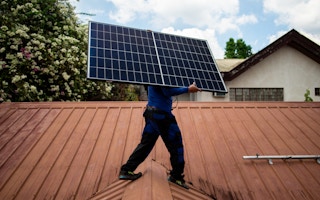Malaysia could save as much as US$250 billion on its cumulative energy system if it aligned its decarbonisation efforts with a 1.5 degrees Celsius scenario, making for a “compelling cost argument”, according to International Renewable Energy Agency (IRENA).
“[Malaysia’s switch to renewable energy] is actually less costly than business as usual, and that is largely a result of the competitiveness of renewable energy technology,” said IRENA’s programme officer Nicholas Wagner at a panel session at Malaysia’s COP27 pavilion in Sharm El-Sheikh, Egypt recently.
However, achieving these cost savings will require higher upfront investments than the energy sector had previously allocated towards an expansion in renewable energy technologies, he said, citing examples of costly initial infrastructure needed, such as energy storage, electric vehicle charging stations and hydrogen electrolysers.
Malaysia’s power sector is currently the largest source of greenhouse gas emissions in the country, accounting for about 80 per cent of national carbon emissions. Its economy is also heavily reliant on oil and gas, which accounts for one-fifth of the country’s gross domestic product.
Although more than 90 per cent of electricity in Malaysia continues to be generated from fossil fuels, the government has reiterated its commitment to increase its renewable energy share to 31 per cent by 2025.
“You most certainly need coordination among all the different government, non-governmental and private sector actors [to realise these renewable energy goals], said Wagner.
IRENA is currently working with Malaysia’s Ministry of Energy and Natural Resources to produce a long-term energy transition outlook and roadmap for Malaysia, which is expected to be released in late January or February next year.
Focus on financing project development, not “bankability”
Malaysia does not need to go it alone in its energy transition efforts, however. “The energy transition that is needed is so substantial that the Asean region also has to coordinate and work together [on it],” Wagner said.
According to IRENA’s estimates, the region will require US$6-7 trillion of investment in the energy transition, of which Malaysia requires US$450 billion.
Among financial actors, multilateral development banks are crucial for financing the energy transition but they are not able to provide capital that is catalytic enough, said Jay Collins, vice chairman of banking, capital markets and advisory at Citigroup and fellow panellist at COP27. Calls were made at the climate change conference for these banks to be reformed in order to better support climate action in developing countries.
“It is absolutely critical that at the end of that reform, not only do we come out of it with more development bank money, but that that capital takes more risks. If it doesn’t mobilise the private sector, we can’t get to these trillions of dollars,” said Collins.
Instead of focusing on the “bankability” of projects, Collins urged private financiers to focus on financing project development instead. “We don’t even have enough projects to see if they are bankable or not,” he said.
This view was echoed by Malaysia’s Khazanah Nasional. The sovereign wealth fund’s senior vice president of investment Elaine Ong called on investors and lenders to be more “courageous” in funding more catalytic projects.
“While we can invest through renewables, we also need to create a good enough ecosystem to catalyse newer technology,” said Ong.
Khazanah itself has taken a blended finance approach with multilateral development banks, among other financing models, to fund projects that have the potential to move the needle within Malaysia’s energy sector, she said. One such investment is the fund’s investment in an early-stage Canadian company focused on general fusion technology, which is not yet commercialised.
According to Collins, if the Malaysian government wants to achieve its Nationally Determined Contribution (NDC) and achieve a just energy transition, it must hold talks with the private sector, which he says makes up 60 per cent of the Malaysian economy.
“The private sector doesn’t invest in NDCs, the private sector invests in projects. We need to move to projects,” he said.










